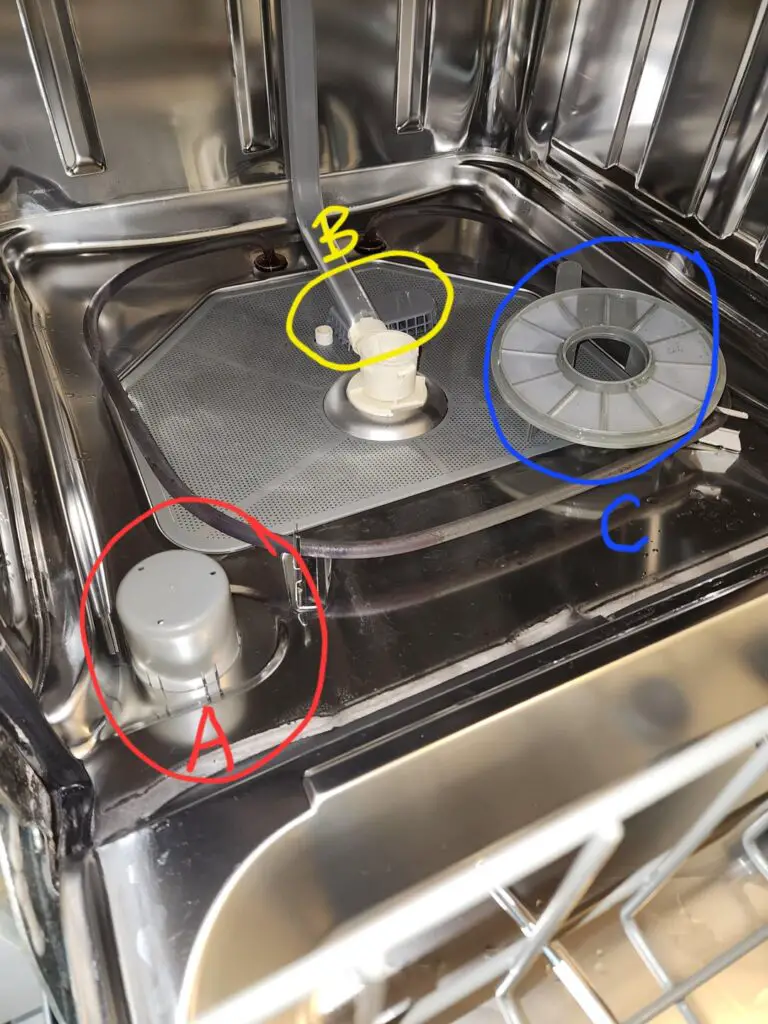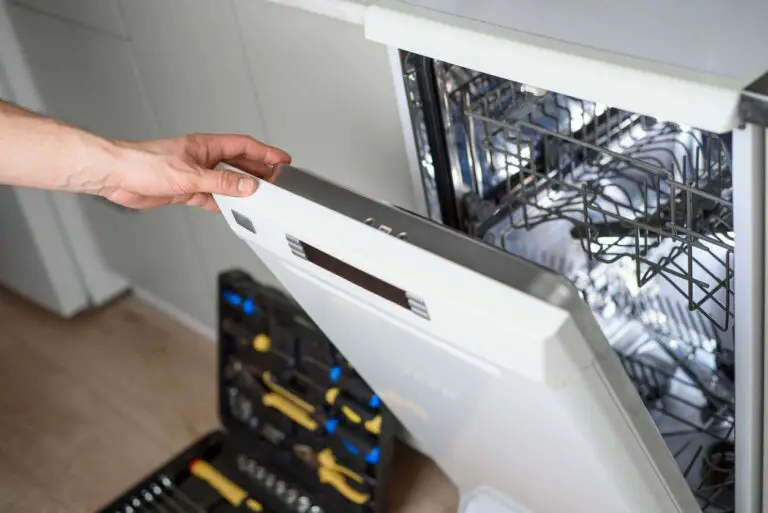How to Perform a Dishwasher Heating Element Test [A Step-by-Step Guide]

Your dishwasher may be a silent hero in your kitchen, diligently washing your dishes day in and day out. But what if one day, it starts leaving your dishes cold and wet? A malfunctioning dishwasher heating element might be the culprit. Now, how should you know whether the heating element is bad or not?
To test a dishwasher’s heating element, turn off power, access the element, often at the bottom, and use a multimeter to check for continuity. No continuity suggests a faulty element, which can cause heating problems in the dishwasher.
However, there are some precautions and necessary tools you should be aware of before you attempt a dishwasher heating element test. Below, let’s cover up these things in detail.
What Is a Heating Element Test for Dishwashers?
The heating element on a dishwasher is a significant part of the washer responsible for heating the water or drying dishes.
Like other components of your dishwasher, this element may also encounter some issues that will affect its performance.
So, it is important to perform regular heating element tests to ensure that your dishwasher is working properly.
Moreover, this test will help you to find out any problem with the heating element and allows you to take proper actions to solve the issue.
In short, we can say that the heating element test on a dishwasher is a diagnostic process of determining the heating element whether it’s functioning properly or not.
Signs Your Dishwasher Heating Element Needs Testing
If you notice that your dishwasher heating element is not working accordingly, there are some common symptoms that indicate it needs testing. Here are the six most common of them:
- Dishes are not getting dried properly.
- The dishwasher fails to clean and sanitize the dishes thoroughly.
- Dishes are still cold, indicating the water isn’t warming up.
- The wash cycle is taking longer than usual as the water is failing to warm up properly.
- Unexpected noises or burning smell coming out during operation.
- The control panel on your dishwasher is showing any error codes related to the heating element.
Tools Needed for a Dishwasher Heating Element Test
Before attempting to test your dishwasher’s heating element, there are a few tools which you must have in your hands. Here are the most essential ones:
- Multimeter: also called multitester or VOM, is used to measure resistance and electrical continuity.
- Alligator Clips: to create temporary electrical connection between multimeter probes and the heating element terminals.
- Screwdriver: to access the heating element and remove the dishwasher’s panel and dish rack.
- Safety gloves and goggles: to secure yourself throughout the process.
How to Conduct a Heating Element Test on Dishwasher?
Once you have all the necessary tools we mentioned earlier, you are all set to test the heating element on your dishwasher. So, here’s an step-by-step guide on how to perform a dishwasher heating element test:
Ensure proper safety
Before you conduct any tests, it is important to ensure safety. Disconnect the power supply to the dishwasher to avoid the risk of electrical damage.
To do so, either disconnect the washer from the outlet or cut off the fuse from the fuse box.
Locate the Heating Element
Once you disconnected the power source, access the heating element in the dishwasher. In most dishwashers, the heating element is located at the bottom of the dishwasher tub.
So, open the door of your dishwasher and look into the tub for the element. The heating element is typically shaped like a circular tube.
Sometimes, it can also be covered. If yours is like that, then you will need to remove the dish rack to uncover the heating element. Once you uncover the heating element, jump into the next step.
Visually inspect the element
The heating element on a dishwasher also tends to be damaged or broken over time. So, visually inspect the heating element for any visible damage or corrosion.
Also, look for any cracks, holes, or discoloration. If you see any signs of damage, then it needs to be replaced and you don’t need to test it for now.
Disconnect wires
If there’s no signs of damage, disconnect the wires connected to the dishwasher’s heating element. In this stage, you must take a note of how they were connected so that you can reassemble them later.
Measure resistance
Now use a multimeter to test the resistance of the heating element. Connect the multimeter’s leads to the terminals of the heating element.
If the reading is showing somewhere between infinity and zero, then this is normal. Because the exact resistance is difficult to say as it depends on the specific model and manufacturer.
But, in most cases, a normal resistance should be between 10 and 30 ohms. So, if the resistance doesn’t move (infinite resistance) or shows zero resistance, then it means a faulty dishwasher heating element that should be replaced.
Common Problems Associated with Dishwasher Heating Elements
Dishwasher heating elements are prone to various issues, damaging their actual performance. Here are some of the most common problems associated with them and their possible solutions:
| Problems | Solutions |
| No heat | Ensure power supply to the dishwasher and test the heating element if it’s getting power |
| Inconsistent heating | Clean the heating element thoroughly; also inspect the temperature sensor |
| The heating element is burned out | Replace the element with the new one |
| The water is not warming up enough | Check the thermostat and replace it if it is faulty |
| Error codes associated with the heating element | Troubleshoot the error codes and replace the heating element if necessary |
What to Do If Your Dishwasher’s Heating Element Fails the Test
There are some issues that can let your dishwasher’s heating element test down. In this case, you should look forward to helping it out as it won’t be so hard.
Here are some steps to follow, if your dishwasher’s heating element fails the test:
- Double-check the whole testing procedure you have conducted.
- Inspect the wiring connections connected to the heating element for any visible damage. Repair or replace the wiring if necessary.
- Clean the heating element if there’s debris or minerals accumulated on it.
- Also, test the thermostat using a multimeter to see if it is faulty. Replace the thermostat if needed.
FAQs
Throughout this discussion, we have discussed the heating element testing procedure. But still you may have some confusion in your thoughts. So, let’s answer some of the most common frequently asked questions related to the topic.
Is it possible to test the heating element without removing it from the dishwasher?
It is possible but it will be hard to test the heating element without removing it from the dishwasher. As the heating element is located at the bottom of the dishwasher, you will need to dislocate it from the washer to properly test the element. It will also allow you to access the internal components.
How do I clean a dishwasher heating element?
You can use a piece of soft damp cloth or a smooth bristol brush to clean the debris from the heating element. But if the debris on the element is hard-to-remove, you can use a cleaning solution of white vinegar to clean it.
Is it normal for a heating element to work partially?
No, this is not OK for a heating element to work partially. It should either work properly or not at all. If you see that the heating element on your dishwasher is working partially, then it might have some issues that should be discovered and fixed ASAP.
Conclusion
A faulty heating element won’t stop your dishwasher from working, but will cause various malfunctions as we discussed. So, if you see any symptom like that you should test the heating element first.
Hopefully, now you also know how you can perform a dishwasher heating element test when it’s needed. But also, don’t forget to check the owner’s manual for specific instructions according to the dishwasher’s model.






